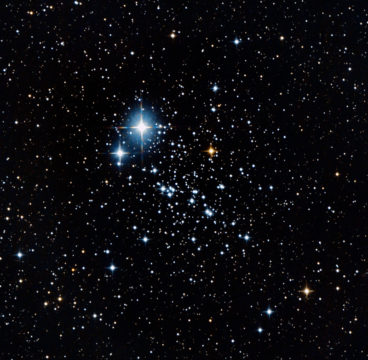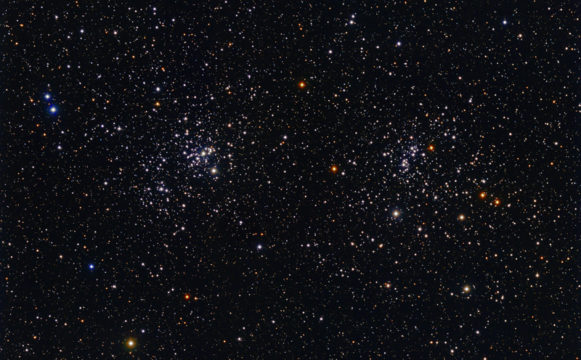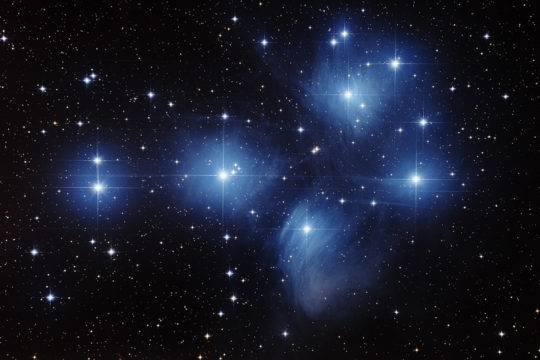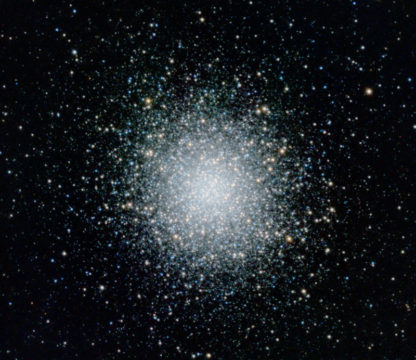Star clusters are a terrific way to practice your astrophotography fundamentals!

Richard S. Wright Jr.
Open star clusters are a great and often overlooked target for moderate focal-length astrophotography (say 500 to 1,200 mm or so). They are also perfect beginner targets for a number of reasons. First, stars are much brighter than galaxies or nebulae of any kind, and it doesn’t take a great deal of exposure time to capture them. Because of this, you can capture star clusters even in the presence of significant light pollution or Moonlight! Also, because of the short exposures needed to record them, clusters are very forgiving of tracking or polar alignment errors.
Open clusters are quite beautiful through the eyepiece and one of my top picks when doing visual astronomy, especially at outreach events with my local club. Think of them as tiny asterisms with a wide variety of images and shapes available. One of my favorites is NGC 457, which to me looks like E.T. with his arms outstretched. Captured photographically, the comparison between the image and the view are a closer optical match than just about anything else, other than solar system objects. Galaxies often look like someone sneezed on the eyepiece, and photographs often mislead the general public as to what to expect when looking through the telescope. Star clusters, though, are much closer to a WYSISYG (what you see is what you get) experience.

Richard S. Wright Jr.
All of this said, I'll confess that many clusters can be nothing more than a rather boring grouping of stars, especially with a refractor. A few notable exceptions, such as the Double Cluster in Perseus, cannot fail to impress, however. For most clusters, to really punch them up aesthetically, I prefer to use a Newtonian reflector rather than a refractor (despite my growing reputation as a refractor snob). A Newtonian's diffraction spikes add a much needed “sparkle” to a group of stars that really elevates them in my mind. I never cheat either and use a plug-in to add diffraction spikes after the fact. Even if shooting through a refractor, you can get diffraction spikes by taping some string or fishing line in a cross pattern across the aperture. I suppose you could consider this cheating too, but at least the diffraction effect is real.

Richard S. Wright Jr.
If you aren't going to take my advice about starting out shooting with a monochrome camera, then star clusters are ideal first targets for one-shot color imaging. A foundational technique is retaining star colors. This is actually pretty easy to accomplish, and there’s no better target to practice on than a good open cluster. The secret is pretty simple, and it’s just to take shorter exposures. This goes against the grain of what has been drilled into our heads about super-long exposures, but a long exposure will often over saturate stars and they will just appear as white. Even over-exposed stars, however, as long as they are not too large, will have a halo of color around them that can be recovered with a careful application of curves (in Photoshop, PixInsight, or other software with non-linear stretching functions). When you’re actually imaging stars instead of faint nebulosity, however, you can get away with much shorter exposures and retain good star color all the way to the core in most stars. There’s always going to be a few really bright ones though, and on those you can practice finessing the halos to get the star colors to show up.

Richard S. Wright Jr.
You’ll be hard pressed to run out of open clusters to shoot, but you can also consider globular clusters as another step up the experience ladder. Globular clusters also do very well under light-polluted skies and will stand up to considerable Moonlight almost as well as open clusters. For example, the image of M13 at right was shot from my backyard not too far from Orlando, Florida. A little diffraction effect on globulars is nice too, but they also (at least in my opinion) do very well with refractors. One of the best tests I know of for optical performance is achieving that powdery dusty feel in the core in the final result. You’ll earn your star color badge when you’re able to retain the blue and amber colors of the stars throughout the cluster too.
 1
1









Comments
Rod
October 15, 2018 at 12:47 pm
Good report and images. I do not take pictures but did enjoy viewing NGC 457 with my 90-mm refractor on 07-Oct-18. Some call it the Owl cluster and I wanted to hoot at it 🙂 I also enjoyed viewing the Perseus Double Cluster on 12-Oct-18 using the 90-mm and my 10-inch Newtonian. These are fun clusters. Later I plan to enjoy looking at M45 in Taurus.
You must be logged in to post a comment.
You must be logged in to post a comment.